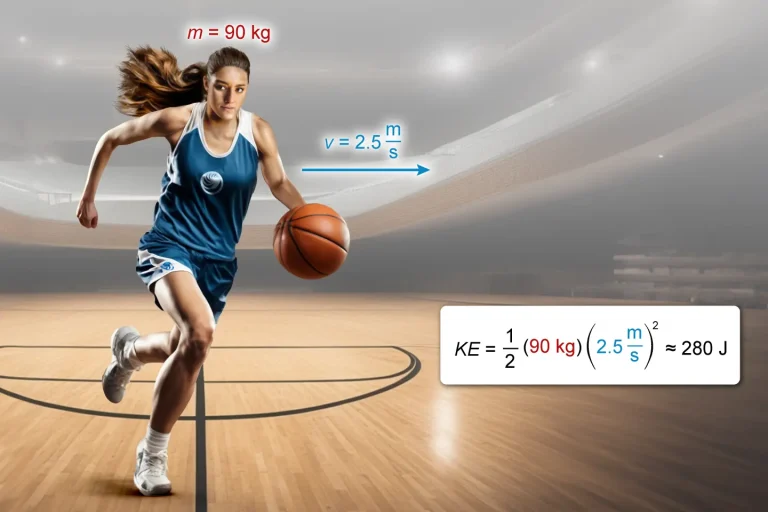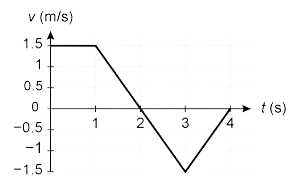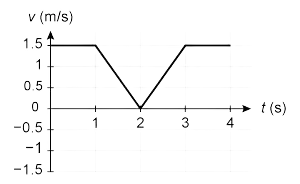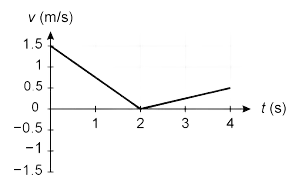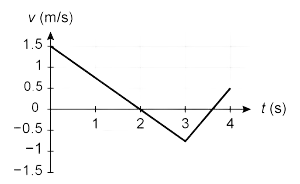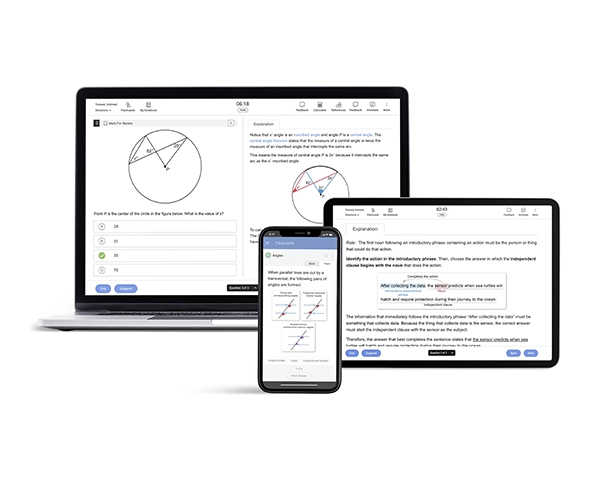There are 7 types of AP Physics 1 multiple-choice questions:
- Text-based questions
- Diagram-based questions
- Data table-based questions
- Graph-based questions
- Calculations required questions
- Image answer-choice questions
- Graph answer-choice questions
- Diagram answer-choice questions
- Questions in sets
Each AP Physics 1 multiple-choice question type is defined below, with tips to help you confidently tackle and select the correct answer. The questions are either discrete or question sets, in which you are provided with a stimulus or a set of data and a series of related questions. For each question type, we provide an example that you will likely see on the exam.
Our AP Physics 1 question bank has hundreds of these questions for you to practice.
Text-Based Questions
This type of question involves text-only information. When you're taking the exam, you will encounter 2 types of text-based multiple-choice questions: short-form and long-form.
- Short-form text questions are knowledge-based and test your ability to recall important fundamental concepts.
- Long-form text questions will include background information that tests your ability to apply that knowledge to a new situation.
You should approach short- and long-form question variations with the same focus, as both types are equally difficult. Short-form questions can assess the most difficult concepts, just as a long-form question could contain much text and information while asking a simple question.
Key tips for answering text-based questions:
- Read the question carefully, noting any key details.
- Use diagrams to track key info as you read long questions. Jot down important points to stay organized and avoid feeling overwhelmed.
This type of question is generally 1 or 2 sentences and will require you to use your content knowledge to answer. Here is an example:
[MCQ Example - Text Only Question]MCQ 1 Example
Scientists want to launch a satellite into a circular orbit such that the satellite always remains directly above the same location on Earth's equator during its orbit. Which of the following procedures will allow the scientists to accomplish this?
- Launch the satellite into an orbit where the satellite' s orbital period equals 12 hours.
- Launch the satellite into an orbit where the satellite's orbital period equals 24 hours.
- Launch the satellite into an orbit where the satellite's linear velocity equals the linear velocity of the location on the equator due to the Earth's rotation.
- Launch the satellite into an orbit where the gravitational acceleration of the satellite equals the gravitational acceleration on the equator.
What You Must Know:
While the question is short, the concepts related to circular motion and gravitational forces need to be well understood and applied to the given question scenario. Using our targeted AP Physics 1 study guide alongside our practice questions will help you solidify your conceptual understanding and answer these kinds of questions.
This type of question gives more information (2-6 sentences) in the question stem. You must often combine this information with your understanding of scientific processes to choose the best answer.
Here is an example:
[MCQ Example - Text Only Question]
MCQ 2 Example
A quarterback throws a football to his receiver with the same velocity three separate times. The receiver jumps straight up off the ground to catch the ball each time. The first throw bounces off the receiver back toward the quarterback, and the receiver moves with momentum p1 . The second throw is caught by the receiver, who now moves with momentum p2. The third throw slips through the hands of the receiver, and he moves with momentum p3. Which of the following correctly ranks the momentum of the receiver immediately after each collision?
- p1 = p2 = p3
- p1 > p2 > p3
- p1 > p3 > p2
- p1 < p2 < p3
What You Must Know:
This longer question format includes a lot more information. Three separate events involving the transfer of momentum are compared, and the small differences between them must be understood from the text. To arrive at the correct answer, you will need to identify the similarities and differences of each case and the physical effect of each.
Diagram-Based Questions
This type of question provides a diagram accompanied by text above and/or below the diagram. This may be a type of diagram you are familiar with (e.g., a free-body diagram), or you may encounter an unfamiliar diagram (e.g., a diagram showing a new experimental setup). By analyzing the diagrams, you can determine the correct answer to the question.
Key tip for answering diagram-based questions:
- Note any labels that seem especially relevant to the question.
You will likely encounter diagrams that you are not familiar with, but don’t let that intimidate you! All the information you need to solve the problem is always provided, and you will learn how to identify important information quickly from various diagrams. Here is an example:
[MCQ Example Image in Question]
MCQ 3 Example

A gate in a fence can swing back and forth about a fixed post, as shown in the figure above. A child throws pebbles of approximately the same mass and with the same initial speed from an angle perpendicular to the gate. At which of the labeled positions on the gate should the child throw a pebble to produce the largest angular displacement of the gate?
- Point A
- Point B
- Point C
- The angular displacement is the same at all positions.
What You Must Know:
This question requires making connections between the concepts of rotational motion and forces. You will need to apply your knowledge of these concepts to the diagram in the question to choose the best answer.
Data Table-Based Questions
This type of question involves a table in the question stem in addition to text. The correct answer requires using data from the table provided and any other information in the question’s text. You may need to recall content knowledge to answer this type of question.
Key tips for answering data table-based questions:
- Examine the information in the table, paying attention to the row and column headings and the table’s title (if present).
- Look for patterns in the data, and circle any data that seems especially relevant to the question.
Here is an example:
[MCQ Example - Image in Question]
MCQ 4 Example
| Body | Mass (ME ) |
Radius (km) |
Gravitational Field Strength (N/kg) |
|---|---|---|---|
| Jupiter | 31.7 | 71400 | 25 |
| Saturn | 95 | 60400 | 10.4 |
| Uranus | 14.5 | 23600 | 10.4 |
| Neptune | 16.7 | 22300 | 13.8 |
The mass, radius, and gravitational field strengths for four planets in our solar system are listed in the table above. Each planet's mass is given as a multiple of the mass of Earth ME. Which of the following correctly ranks the period P of identical pendulums near the surfaces of each planet?
- PJupiter > PSaturn > PUranus > PNeptune
- PSaturn > PJupiter > PNeptune > PUranus
- PJupiter > PNeptune > (PUranus = PSaturn)
- (PSaturn = PUranus) > PNeptune > PJupiter
What You Must Know:
For this question, you need to have a strong understanding of gravitational field strength and the motion of a pendulum. By using this knowledge in conjunction with the table’s data, you will be able to arrive at the correct answer.
Graph-Based Questions
This type of question will provide you with a graph displaying data and a text description related to that graph. You must use your graphing knowledge to select the best answer and extract important information quickly.
Key tip for answering graph-based questions:
- Pay attention to the labels on the axes, the legend (if present), and the information given in the caption below the graph (if present).
Here is an example:
[MCQ Example Image in Question]
MCQ 5 Example
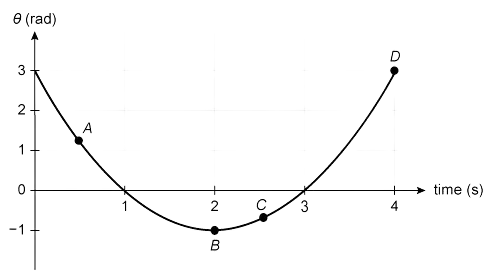
The figure above shows the graph of angular displacement as a function of time for a disk rotating with constant angular acceleration. The angular velocity and angular acceleration of the disk are both positive values at which of the labeled positions?
- Position B only
- Positions A and D only
- Positions C and D only
- Position D only
What You Must Know:
This question focuses on your understanding of rotational kinematics and requires a quick recall of the relationship between displacement, velocity, and acceleration. By using this knowledge with the graph in the stem, you will be able to select the best choice.
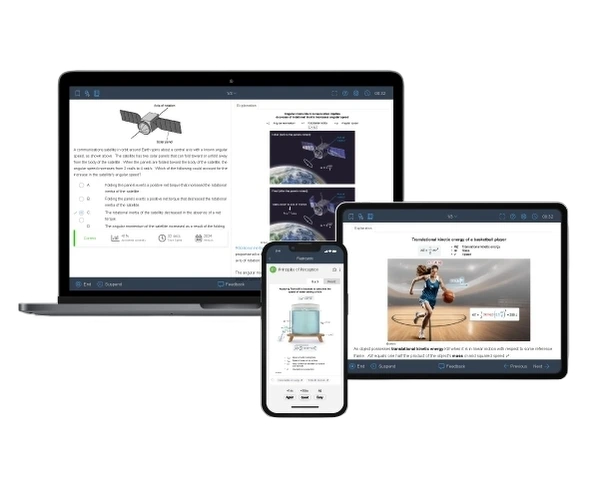
Calculation Questions
This type of question involves taking the information provided in the question stem and performing a calculation to get the correct answer.
Key tip for answering calculation questions:
- Pay close attention to details, labels, headings, and legends, as you would with text, tables, or graphs.
- Round only at the final step of your solution.
Remember that you will have an AP Physics 1 equation and formula sheet to refer to on the exam, and you may also use an approved calculator to arrive at the best answer for the question. Here is an example:
[MCQ Example Image in Question]
MCQ 6 Example
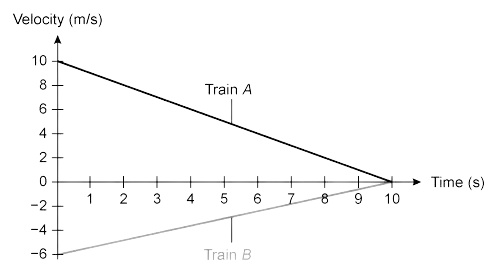
Two freight trains, A and B, approach each other on the same track from opposite directions. To avoid a collision, both trains begin to slow down at t = 0, when they are separated by 150 m. The velocity of each train as a function of time is shown above. What is the final separation between the trains when they come to rest?
- 0m
- 20m
- 50m
- 70m
What You Must Know:
In addition to your graphical skills, you will need to understand how to apply concepts related to one-dimensional motion to this question.
Image Answer-Choice Questions
This question type is a bit more complex because instead of choosing a sentence or numerical option as the best answer, you must choose an image, such as a graph or diagram, that best represents the answer. You must apply the information in the stem and sometimes your content knowledge to select the best image choice.
These AP Physics 1 MCQs will require you to select the answer choice with the best graphical representation of the question.
Key tips for answering graph answer-choice questions:
- Carefully examine each answer choice graph, noting axis labels, units, and legend information.
- Pay attention to any parts of the graphs that seem especially relevant to the question.
Here is an example:
[MCQ Example - Images in Answer]
MCQ 7 Example
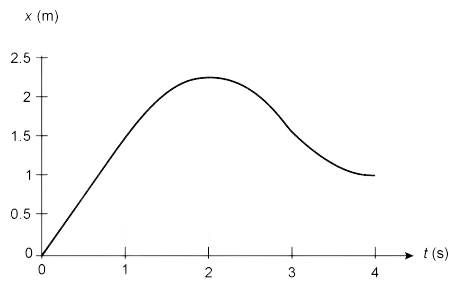
Using a motion detector, a group of students record the motion of a cart on a horizontal track and produce a graph of the position of the cart as a function of time, as shown above. Which of the following graphs best represents the cart's velocity as a function of time?
What You Must Know:
This question contains a lot of graphs and information related to linear kinematics. Apply your knowledge to choose the best answer.
These questions will require you to select the diagram that best represents the answer to the question.
Key tip for answering diagram answer-choice questions:
- Examine each answer choice diagram, noting labels and units.
Here is an example:
[MCQ Example Images in Answer]
MCQ 8 Example

Students analyze the motion of a puck on an air table, which is not level, and use a motion detector to produce graphs of the x- and y-components of the puck′s velocity as a function of time, as shown above. If the +x-direction is east and the +y-direction is north, which figure below most closely approximates the direction of the net force on the puck?
What You Must Know:
This question assesses knowledge of linear motion, graphical analysis, and vectors. You will relate various representations of information and make connections quickly in order to select the best answer.
Questions in Sets
All AP Physics 1 MCQs in a set are tied to a particular stem that may also include graphs, tables, or diagrams. The stem associated with the set of questions should be read first.
Each question set will typically contain 2-3 questions. Question sets may contain any of the previously introduced question types, and the stem will likely be used. Additionally, you must apply your content knowledge to make the best choice.
Key tips for answering questions in sets:
- Read the question stem and review any figures (graphs, tables, diagrams).
- Note any key info from both the shared stem and each question.
Here is an example:
[MCQ Example Passage in Question]
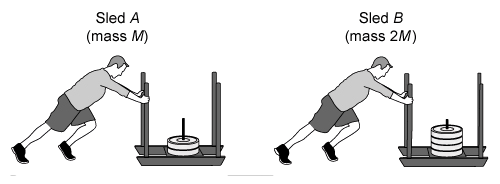
An athlete trains by pushing sleds across a level playing field, as shown in the figure above. Sled A has a mass of M, and sled B has a mass of 2M.
MCQ 9 Example
During a workout, the athlete exerts an average force of 1,000 N on sled A by pushing it 25 m in 20 s. The athlete then exerts an average force of 1,000 N on sled B by pushing it 20 m in 10 s. How does the power the athlete exerts on the two sleds compare, and why?
- The athlete exerts more power on sled A because it is pushed a greater distance over a longer time.
- The athlete exerts more power on sled B because even though less work is done on sled B, it is done in less time than on sled A.
- The athlete exerts the same power on each of the two sleds because the same amount of force is exerted on both.
- The athlete exerts the same power on each of the two sleds because the larger mass of sled B is offset by the greater amount of work done on it.
What You Must Know:
This question requires knowledge of forces and energy, which you will use to make connections between the information provided in the stem of the question and the stem of the question set to choose the best answer.
Now that you're familiar with AP Physics 1 multiple-choice questions and answers, it's time to start practicing. UWorld's AP Physics 1 online course will help you prepare effectively, highlighting your strengths and areas for improvement. Best of luck!
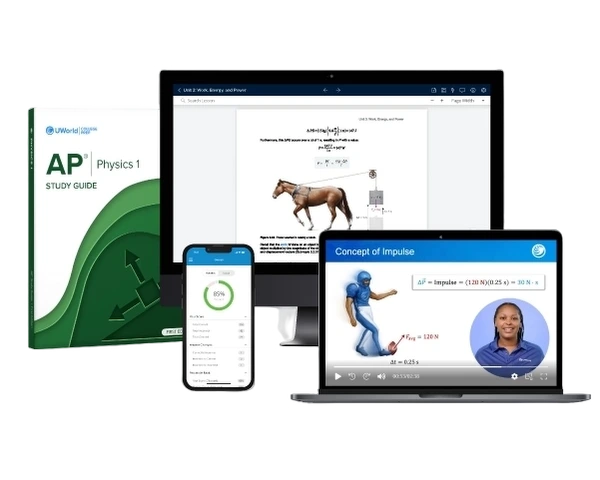
References
- AP Physics 1. (n.d.). apcentral.collegeboard.org. Retrieved from https://apcentral.collegeboard.org/courses/ap-physics-1
- AP Physics 1: Algebra-Based Course and Exam Description. (Fall 2024). apcentral.collegeboard.org. Retrieved from https://apcentral.collegeboard.org/media/pdf/ap-physics-1-course-and-exam-description-effective-fall-2024.pdf
Read More About the AP Physics 1 Exam
Approach free-response questions with confidence. This guide will help you tackle AP Physics FRQs, with expert tips and sample questions to boost your prep.
How to Study for AP Physics 1 ExamUse UWorld's expert study plan for AP Physics 1 MCQ and FRQ sections, featuring proven tips and strategies to help you study effectively and score high.
AP Physics 1 Course and Exam DescriptionThe College Board's CED pdf can be extensive. We've got your back—we condensed the lengthy 200+ page manual into a few pages for the AP Physics 1 Course.
Best AP Physics 1 Review Course ComparisonAre you wondering which AP Physics 1 prep course is the best? Explore this in-depth review of top courses to find the perfect fit for your exam preparation.
Best AP Physics 1 Study Guide ComparisonCompare Kaplan, Barron’s, Princeton Review, and UWorld to find the best guide. Discover strategies, features, and resources to help you ace AP Physics 1.
How to Self-Study for AP Physics 1Self-study AP Physics 1 with our study plan! Gain expert tips, essential tools, and proven strategies to confidently prepare and ace the exam with success.
